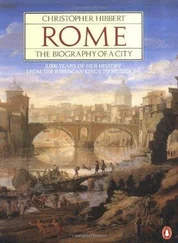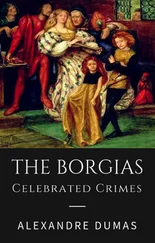The painter chosen by Alexander VI to decorate his apartments was one Bernardino di Betto di Biagio, better known as Pinturicchio, the gifted painter from Perugia who had established a reputation in Rome as the leading painter of works in the new ‘imperial style.’ He, too, must have crawled through the filthy dark passageways into Nero’s palace, although he did not leave his signature among the gilded stucco work.
Giorgio Vasari was less impressed with his talents:
Even as many are assisted by fortune without being endowed with the necessary talent, so, on the contrary, there are infinite numbers of men of ability who suffer from an adverse and hostile Fortune… it pleases her to use her favour to raise certain men who would never be known by their own merit, as is the case with Pinturicchio of Perugia.
Pinturicchio’s work for the pope, however, much pleased his patron, who rewarded the artist with grants of land in the Papal States. Alexander VI’s apartments are a forceful monument to the Borgia family. Borgia symbols, most emphatically the Borgia bulls — in one depiction mounted by a cupid — strike the eye, as do the symbols of the House of Aragon from which the pope chose to trace his ancestry. More bizarrely, on the ceiling of the so-called Sala dei Santi were images of the ancient Egyptian deities Isis and Osiris, from whom, according to one of the pope’s secretaries, Alexander VI could also trace his descent.
The rooms had other family connections. Lucrezia was portrayed as St Catherine of Alexandria, defeating the pagan emperor by the force of her argument; Jofrè and Sancia appear as a young couple in the crowd behind her, while Juan, Duke of Gandía, can be seen, superbly dressed as he always was in life, astride a white charger, and Cesare glares out of the picture from behind the throne of the disputing emperor.
Alexander VI himself appears in the fresco of the Resurrection , witnessing this dramatic moment in an attitude of prayer, gorgeously attired in an embroidered and bejewelled chasuble, with a skullcap over his balding head, his hands clasped in prayer, his tiara on the ground before him. Over the door of one room, Pinturicchio painted another portrait of Alexander VI, this time adoring a beautiful Virgin, to whom, according to Vasari, he gave the face of Giulia Farnese.
While Pinturicchio and his assistants were at work in the Vatican Palace, painters, sculptors, and builders were also busy elsewhere in Rome at Alexander VI’s behest. At St Peter’s they finished the grand fountain in the piazza, which had been started by Innocent VIII, and adorned it liberally with the Borgia bulls. They also added a second storey to the Benediction loggia at the end of the piazza, where, a few years later, the pope would narrowly avoid being hit by an iron torch-holder that fell down while he was watching a bullfight; and they built a new road from Castel Sant’Angelo to the Vatican, which the pope named Via Alessandrina (now Borgo Nuovo).
Alexander VI also commissioned repairs to several churches in Rome, including San Giacomo degli Spagnuoli, the church favoured by the Spanish colony in the city; as a cardinal he had spent a considerable sum on an elaborate marble relief of the Virgin and child for the high altar in Santa Maria del Popolo, with the Borgia bulls prominently on display on shields held by putti (now in the sacristy of the church).Most memorably, he also paid for a magnificent gilded ceiling for the Basilica of Santa Maria Maggiore, his financial contribution marked, once again, by liberal quantities of Borgia bulls; the gold, it was said, was the first to have come from the mines of Peru and had been presented to the pope by Ferdinand and Isabella of Spain.
The most famous work of art from Alexander VI’s pontificate, however, was the Pietà by Michelangelo Buonarotti, commissioned not by him but by the ambassador of the king of France. Michelangelo had arrived in Rome from Florence on June 25, 1496, to work under the patronage of Cardinal Raffaello Riario, who had spent 200 ducats on a life-size sleeping cupid by the sculptor under the impression that it was a work by one of the famous sculptors of antiquity.
Soon after his arrival in the city, ‘a broad field in which a man may demonstrate his worth,’ as he described it, Michelangelo called upon Cardinal Riario in his grand palace, built, it was rumoured, with the money he had made gambling with Franceschetto Cibò, the son of Innocent VIII. The cardinal asked the sculptor if he could produce some ‘beautiful work’ for his collection: ‘I replied that I might be able to make such splendid works as he possessed in his palace,’ Michelangelo recorded, ‘but we would see what I could do; so we have bought a piece of marble for a life-size figure, and I shall start work on it next Monday.’
The result of this commission was the plump and drunken Bacchus that can now be seen in the Bargello in Florence. The subject and the treatment evidently did not please the cardinal, who, it seems, rejected it, and it was later to be seen among the antique pieces in the garden of Jacopo Galli, Michelangelo’s banker.
Michelangelo, however, soon found another patron in the French Cardinal Jean Bilhères de Lagraulas, who commissioned the Pietà for his tomb in the French royal chapel in St Peter’s, dedicated to St Petronilla, and provided him with a letter of recommendation to the officials of the small republican city-state of Lucca, through which the sculptor would have to pass on his way to the white marble quarries of Carrara: ‘We have recently agreed with master Michelangelo di Ludovico, Florentine sculptor and bearer of this letter, that he make for us a marble tombstone, namely a clothed Virgin Mary with the dead Christ naked in her arms, to place in a certain altar which we intend to found in St Peter’s in Rome,’ ran the letter, explaining that Michelangelo ‘was presently repairing to those parts to excavate and transport here the marbles necessary for such a work and we beg your lordships… to extend to him every help and favour in this matter.’
The finished Pietà , described as ‘the most important artistic commission of the age,’ and now to be seen in St Peter’s, was being admired by a group of visitors from Lombardy, so the story goes, when Michelangelo happened to be passing by. He heard one of the group explain to the others proudly that the fine work was by ‘our Gobbo of Milan.’ Michelangelo said nothing, but later he returned to St Peter’s in the middle of the night and, by the light of a lamp, carved his name on the band that runs diagonally between the Virgin’s breasts.
Proud as he was of this work, Michelangelo, the ‘ statuario fiorentino ,’ was not happy in the Rome of Pope Alexander VI, which he described as violent and materialistic, and was relieved when the time came for him to return to Florence. ‘Here they made helmets and swords out of chalices,’ he wrote of Rome at this time.
They sell the blood of Christ by bucketfuls
And cross and thorns are lances and shields
And even Christ all patience loses
But let him come no more to these city streets
For here his blood would flow up to the very stars
Now that in Rome they sell his skin
And they have closed the roads to all goodness.
Alexander VI’s most expensive projects, on which he expended huge sums, were the fortifications that he commissioned in defence of the papal territories. In the Papal States he built and maintained numerous castles and other defences, as well as financing a small fleet of galleys, which were needed to protect the coasts from pirates, and taking the necessary measures to ensure that the roads throughout his territories were kept as clear as possible from brigands. Large sums were also spent on military equipment, particularly on artillery, while many thousands of ducats were expended on crusading funds and subsidies to Venice for fleets deployed against the Turks.
Читать дальше











